Exploring Homemade Ranch Dressing Ingredients


Intro
Crafting your own ranch dressing at home isn’t just about whipping up a quick dip for veggies or salads; it’s a culinary adventure that unlocks a spectrum of flavors. Ranch dressing, known for its creamy texture and zesty zing, is a staple in many households but seldom do people appreciate its roots or experiment beyond the standard recipe. In this article, we’ll take a closer look at the components that bring this dressing to life.
Moving beyond the commonplace, we’ll explore unique alternatives that cater to various dietary preferences and lifestyles. Whether you’re vegan, gluten-free, or simply looking to jazz things up in the kitchen, understanding the ingredients and their purpose is crucial. This knowledge can elevate your ranch dressing from merely satisfactory to absolutely extraordinary. Get ready to dive into this comprehensive guide that balances tradition with innovation!
Preamble to Homemade Ranch Dressing
Homemade ranch dressing holds a special place in the culinary hearts of many. As a creamy and flavorful accompaniment, it transforms an ordinary salad into a delightful culinary experience. But why is this dressing so beloved? It’s not just the taste; it’s also the ability to customize the flavors to meet personal preferences or dietary restrictions. In this section, we will look at the reasons behind its popularity, the benefits of making it yourself, and how to navigate the world of ranch dressing ingredients.
The Popularity of Ranch Dressing
Ranch dressing has climbed the popularity charts and continues to reign supreme in American households. According to industry statistics, it’s often cited as the most consumed dressing in the country. This affinity for ranch stems from its versatility. Whether drizzling it over crisp salads, dipping veggies, or slathering it on a sandwich, ranch dressing meets a myriad of culinary demands.
One reason for its widespread appeal is the familiar balance of flavors. The creaminess meshes perfectly with herbs and spices, creating a taste that complements many dishes. Furthermore, ranch dressing is often a staple at gatherings and parties, providing an ever-reliable option for those craving something savory yet satisfying.
Why Make It at Home?
Making ranch dressing at home comes with a plethora of advantages. For starters, there’s the freshness factor. Store-bought dressings can be laden with preservatives and artificial flavors. When you craft it yourself, you control the ingredients. Want to swap out sour cream for Greek yogurt? No problem. Prefer a dash of chipotle for a spicy kick? Go for it!
Moreover, homemade ranch allows for creativity that store-bought brands simply cannot match. You can experiment with different herbs, spices, and even oils, tailoring each batch to your liking. Plus, there’s a certain satisfaction that comes from crafting your own condiments. It’s not just about taste; it’s also about the pride of saying, "I made this."
In essence, the journey of making homemade ranch dressing is as delightful as its taste. It presents an opportunity for culinary exploration, inviting novice and seasoned cooks alike to explore the delightful world of ranch dressing ingredients.
"Crafting your own ranch dressing allows you to embark on a flavorful journey that reflects your unique tastes."
As we move forward, we will delve deeper into the core ingredients, herbs, seasonings, and the nuances that make homemade ranch both an art and a science.
Core Ingredients of Traditional Ranch Dressing
When discussing homemade ranch dressing, understanding its core ingredients is pivotal. These components form the foundational flavors that define this classic condiment. Each ingredient not only contributes to the taste but also plays a role in texture and overall balance. In a world where store-bought options abound, crafting your ranch dressing allows for control over quality and flavor, ensuring a custom-made accompaniment for various dishes. Let’s dive into the heart of ranch dressing to explore its essential elements.
Base: The Role of Buttermilk
Buttermilk holds a paramount position in ranch dressing. Not just a simple ingredient, it adds tang and depth to the dressing, elevating it from ordinary to extraordinary. The natural acidity of buttermilk enhances the overall flavor profile and delivers a subtle creaminess without being too heavy. This acidity works wonders in cutting through the richness of other ingredients like mayonnaise and sour cream, creating a balanced experience on the palate.
A lot of folks mistakenly believe that buttermilk is merely a milk by-product. In reality, it is fermented and contains beneficial probiotics. These can aid digestion and contribute to a unique taste that fresh milk simply can’t replicate. Using real buttermilk, rather than substitutes, is key; it’s worth seeking out.
- Tips for selecting buttermilk:
- Opt for cultured buttermilk for that ideal tanginess.
- Check expiration dates to ensure freshness.
“Fresh ingredients make all the difference. Getting the right buttermilk can turn an okay dressing into a standout.”
Creaminess: Mayonnaise and Sour Cream
Another essential duo in ranch dressing is mayonnaise and sour cream. Combining these two results in that rich, velvety texture that ranch is famous for. Mayonnaise brings a luscious creaminess and a slight tang, while sour cream contributes that characteristic sharpness that livens up the overall flavor.
Many people have their preferred percentages when crafting ranch dressing. Some might opt for heavier on mayo to maximize richness, whilst others lean towards sour cream for a lighter option. It’s all about personal preference and what you’re looking for in your dressing.
- Considerations for mayo and sour cream:
- Use high-quality mayonnaise made with egg yolks for the best flavor.
- Full-fat sour cream typically yields a more luxurious texture than low-fat alternatives.
Experimenting with proportions can lead to interesting results, giving your ranch dressing its distinct personality. Whether you aim for more tang, creaminess, or a combination of both, understanding the role of each ingredient leads to a ranch that you’ve tailored to suit your taste.
Herbs and Flavor Enhancers
In the world of homemade ranch dressing, the role of herbs and flavor enhancers goes beyond mere taste. They form the backbone of the dressing, giving it the personality that turns an ordinary dip into a crowd-pleaser. Fresh herbs bring an essence of the garden, while dried options are excellent for those who prefer convenience. Let's explore what these flavor agents contribute to the overall recipe and how to get the most out of them.
Fresh Herbs: The Garden's Touch
Fresh herbs offer a vibrant punch that elevates ranch dressing to another level. Their incorporation is crucial for achieving that fresh, homemade flavor. Each herb has its unique profile, with benefits and characteristics that make them stand out.
Chives
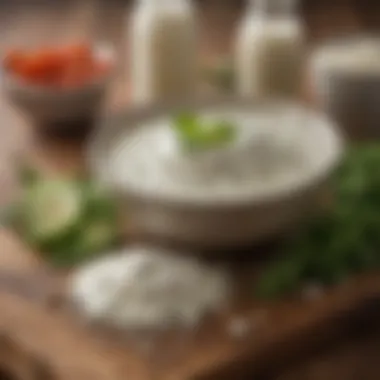
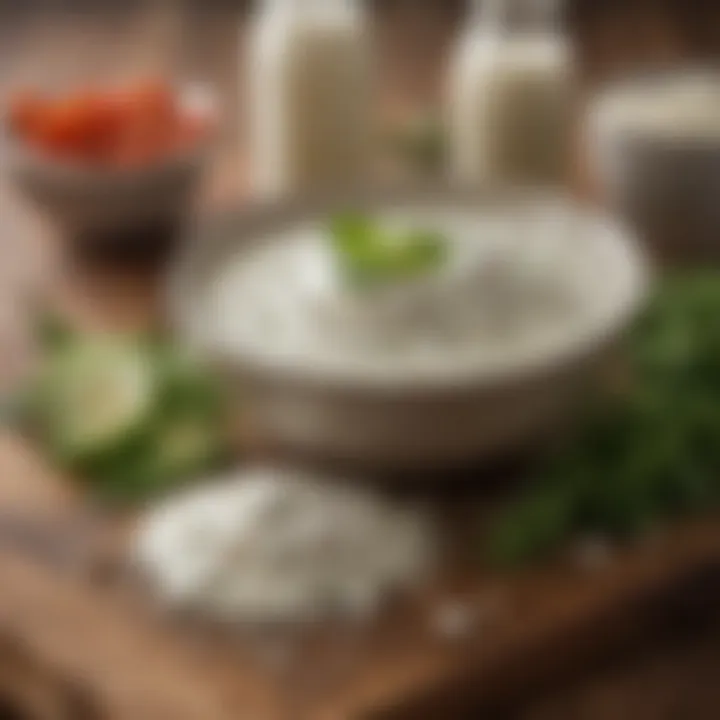
Chives are a delightful addition that brings a mild onion flavor, ideal for those who find regular onions too overpowering. Their soft green color also adds visual appeal to the dressing. A key characteristic that makes chives a favored choice in ranch recipes is their subtlety; they don't dominate the flavor but rather enhance it.
Incorporating chives provides an advantage in texture as well since they blend smoothly without creating an overpowering crunch. However, one must be cautious about using them in excess. They can easily be overshadowed by stronger flavors if not balanced properly.
Parsley
Parsley is often considered the jack-of-all-trades when it comes to seasoning. Its fresh, grassy notes lighten the ranch dressing, making it a beloved herb in culinary circles. One distinctive feature of parsley is its versatility; it complements a wide range of flavors, making it beneficial for perfecting the ranch dressing's overall taste. Unlike some herbs, parsley does not leave an overwhelming aftertaste, which is an advantage for those who are a bit picky. However, too much parsley can result in a somewhat diluted ranch flavor, so wield it with care.
Dill
Dill is the herb that can truly make your ranch dressing shine. It has a unique, slightly sweet profile that can elevate the taste of your dressing significantly. Known for its aromatic leaves, dill brings a refreshing quality that is not only pleasant but harmonious, creating a balance with the creaminess of the ranch. Its advantage lies in its aromatic oils; a little goes a long way, meaning it’s often sufficient to use just a small handful in your dressing.
On the flip side, dill can easily dominate, especially if added in large quantities, so it's wise to add just a tad and adjust according to your taste.
Dried Herb Alternatives
For those who might not have access to fresh herbs or simply prefer the convenience, dried herb alternatives serve as reliable and flavorful substitutes. Dried herbs can provide a more intense flavor due to the concentration that happens during the drying process. While they may lack the vibrant freshness of their live counterparts, they bring their own charm and are often more accessible.
Some common dried herb options include:
- Dried Dill: A great choice when fresh isn't available, though use a smaller amount as the flavor is more potent.
- Dried Parsley: It works well in a pinch and is a staple in many spice cabinets.
- Dried Chives: While they lose some of their nuance when dried, they are still useful for adding a hint of color and onion flavor.
Using dried herbs can also make the preparation quicker and less fragile. However, it's important to remember that dried herbs often require a bit more time to rehydrate and impart their flavor fully, so ideally, let your mixture sit for at least 30 minutes before serving.
Using a mix of fresh and dried herbs can provide a unique depth to your ranch dressing, balancing convenience with flavor.
Seasoning Essentials
When crafting homemade ranch dressing, the significance of seasoning cannot be overlooked. Seasonings are what give ranch dressing its distinctive flavor profile, elevating it beyond casual dips or dressings. Seasoning essentials like garlic and onion powders, along with salt and pepper, guarantee that every bite is packed with flavor. These ingredients do more than just add taste; they create a harmonious balance that can make or break the overall experience of the dressing, allowing it to shine against whatever it is paired with.
Garlic and Onion Powders
Garlic and onion powders are often the secret weapons in flavor enhancement. Their dry forms ensure that they integrate well into the creaminess of the dressing without introducing unwanted moisture. Garlic powder, with its robust and slightly sweet notes, lends a savory foundation. When combined with onion powder, which has a more subdued sweetness with a hint of warmth, the two create a symphony of savory richness in the dressing.
Benefits of using these powders include:
- Convenience: They offer a straightforward way to infuse flavor without the need for chopping or food prep.
- Shelf-stability: Unlike fresh onions and garlic, they won't spoil quickly, making them an excellent go-to option for home cooks.
- Consistent flavor: The intensity of flavors is predictable, giving the dressing a reliable taste every time.
When you opt for garlic and onion powders, you're tapping into a world of flavor that will not overpower, but rather complement the dressing's other ingredients.
Salt and Pepper: Balancing Act
A dusting of salt and pepper does more than just add flavor; it sets the stage for everything else. Salt acts like a flavor amplifier. It brings out the nuances within the ranch dressing, helping all the other elements like buttermilk and herbs to really sing. Too little salt and you might end up with a bland dressing; too much, and you ruin the balance.
Similarly, pepper adds a subtle warmth and a slight kick, acting almost like a seasoning tie that brings all flavors together, ensuring a well-rounded plate. Consider these elements carefully, as they can significantly change the final dish.
"A little pinch of salt can make the flavors dance, while a dash of pepper can warm the heart of the dish."
When using salt and pepper, consider:
- Quality of ingredients: Opt for fine sea salt or kosher salt for better flavor control. Freshly cracked black pepper will fare better than pre-ground versions, which can lose their potency over time.
- Taste as you go: It can’t be stressed enough; tasting is critical. Adjust gradually, so you can land on that perfect balance that makes your dressing stand out.
Vinegars and Acidic Components
In the realm of homemade ranch dressing, vinegars and acidic components play a pivotal role. These ingredients not only bring a refreshing zing to the dressing but also act as a vital balancing factor, harmonizing the creaminess introduced by mayonnaise and sour cream. A splash of acid can elevate the flavors, cutting through the richness and leaving a bright aftertaste that lingers. It’s a fundamental element that shouldn’t be overlooked, as it significantly contributes to the overall character of your ranch dressing.
The Role of White Vinegar
White vinegar is perhaps the most commonly used acidic component in ranch dressing. Its sharp, clean flavor provides a foundation that complements the myriad of herbs and spices involved. When added, it brings out the best in other ingredients, highlighting their natural flavors. Not to mention, it also plays a critical role in preservation, helping to keep your homemade ranch fresh longer.
There are a few key reasons behind the preference for white vinegar:
- Neutral Flavor: It won’t overpower the dressing; instead, it enhances the underlying flavors of herbs.
- Versatility: Works well in various salad dressings and can easily be found in most kitchens.
- Preservative Qualities: As a natural preservation agent, it can extend the shelf life of your ranch dressing.
"A good balance of acidity is key to unlocking the potential of your ranch dressing. Too little, and it can feel flat; too much, and it can overwhelm the palate."
Alternatives: Lemon Juice and Others
While white vinegar holds its ground, there are several alternatives that can add their unique twist to homemade ranch dressing. Lemon juice, for instance, brings a vibrant citrus flavor that pairs wonderfully with the herby components of ranch dressing. It offers a brightness that white vinegar doesn’t, with a touch of sweetness. Here’s a short list of other viable alternatives:
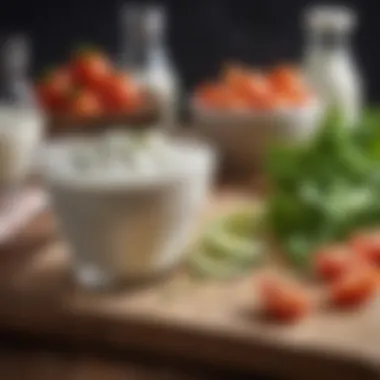

- Apple Cider Vinegar: Adds a slight apple flavor while providing a softer acidity.
- Red Wine Vinegar: Offers a richer taste, making it suitable for more robust flavors.
- Balsamic Vinegar: While sweeter, it can impart a deeper complexity to the dressing, though it should be used sparingly due to its dominant flavor.
In choosing an acid, consider how it harmonizes with the rest of your ingredients. Experimenting with different options can lead to exciting discoveries, enhancing not only the flavor profile but also the joy of crafting your own unique ranch dressing.
Alternative Ingredients for Specialized Diets
Dietary restrictions can often make the culinary experience less enjoyable, especially when it comes to popular condiments like ranch dressing. Thankfully, with a bit of creativity, it’s possible to craft a delicious ranch dressing that caters to diverse dietary needs. Exploring alternative ingredients not only allows for inclusivity but also opens the door to unique flavors and textures that can be just as delightful as the traditional version.
Dairy-Free and Vegan Options
Plant-Based Mayonnaise
When it comes to dairy-free ranch dressing, plant-based mayonnaise stands as a flagship ingredient. This type of mayonnaise is typically made from oils, vinegar, and plant-based egg substitutes, offering a creamy texture without any egg or dairy content. The key characteristic of plant-based mayonnaise is its ability to mimic the richness of traditional mayonnaise, making it a seamless substitute in ranch dressing recipes.
One of the unique features of plant-based mayonnaise is its versatility. It can be flavored and seasoned just like any mayonnaise, giving you the flexibility to adjust your ranch dressing to suit your palate. However, it’s worth noting that some brands may have added sugars or preservatives, which could alter the flavor profile, so careful label reading is essential.
Dairy-Free Milk Alternatives
Every good ranch dressing needs a liquid component, and dairy-free milk alternatives are crucial in this regard. Options like almond milk, soy milk, or oat milk can create a light yet creamy base to balance out the flavors. The key characteristic that makes dairy-free milk alternatives popular is their ability to provide creaminess without lactose, catering specifically to those who are lactose intolerant or following vegan diets.
One unique advantage of choosing milk alternatives is the diverse range of flavors available. For instance, unsweetened almond milk offers a nutty twist, while oat milk can impart a subtle sweetness. However, some dairy-free milk can sometimes dilute the flavor of the ranch dressing, so selecting a full-bodied option is vital to maintaining the dressing's richness.
Low-Fat and Lighter Versions
Creating a lighter version of ranch dressing doesn’t mean sacrificing taste. Low-fat alternatives open up possibilities for those monitoring their diet without missing out on the enjoyment of this classic condiment. Ingredients like low-fat sour cream or yogurt can reduce calorie content while keeping the creamy texture intact.
Using variations like Greek yogurt not only lightens the dressing but also increases protein content, adding a nutritional punch. However, balancing the tanginess of these lighter ingredients is critical to avoid overpowering the dressing's flavor.
Exploring alternative ingredients for specialized diets allows your ranch dressing to adapt to various preferences without compromising on taste.
Through these thoughtful substitutions, homemade ranch dressing can cater to a wide range of diets—allowing everyone to enjoy its zesty goodness. Experimenting with different options not only encourages a wider palette but also highlights the creativity in crafting your culinary expressions.
Ingredient Variation and Its Impact on Flavor
Understanding how ingredient variation affects the flavor profile of homemade ranch dressing is crucial for anyone looking to elevate their culinary creations. Not all ranch dressings are created equal, and small adjustments in ingredients can yield vastly different taste experiences. By exploring various components, food lovers can tailor ranch dressing to their personal preferences while discovering new and exciting flavor combinations.
When it comes to ingredient variation, especially herbs and spices, the influence is twofold: the freshness of the herbs and the proportions used. Freshly chopped herbs like chives or parsley can lend a bright, vibrant flavor, while dried alternatives can offer a more concentrated essence. Understanding how these elements interplay allows one to craft a dressing that not only complements dishes but also truly enhances the overall dining experience.
In addition, tweaking the acidity through the use of different vinegars or citrus juices can balance out creaminess, achieving a more harmonious blend of flavors.
Experimenting with Different Herbs
Testing out various herbs is a fun and rewarding way to customize ranch dressing. While traditional recipes often call for dill, parsley, and chives, there is a whole world of herbs that can add depth and character to your dressing.
For instance, basil imparts a slightly sweet, aromatic flavor, while cilantro can give a refreshing kick that sets it apart. Here are a few suggestions for experimenting with herbs:
- Basil: Adds a rich sweetness and pairs well with garlic.
- Cilantro: Gives a fresh, zesty twist that can brighten the dressing.
- Tarragon: Introduces a slightly anise-like flavor that can elevate the dressing with a gourmet touch.
Moreover, herb combination can create unique profiles. Mixing thyme and dill might invoke a more earthy, rustic dressing. On the other hand, using mint with yogurt can lend a cooling effect, particularly suited for hot summer salads or grilled vegetables.
Balancing Creaminess with Acidity
The creaminess of ranch dressing often overshadows its acidic components, but both play crucial roles in achieving the desired flavor. A well-balanced ranch dressing should not be too heavy or too tangy, so finding the right proportion is key. For example, if you opt for a tangy Greek yogurt base instead of sour cream, complementing it with a splash of lemon juice can enhance the overall flavor.
To get the balance right, consider these tips:
- Adjust Ratios: If your dressing seems overly creamy, try adding more vinegar or lemon juice gradually until you reach a flavor balance.
- Taste as You Go: Flavors evolve as ingredients mix; a little tasting can guide your adjustments.
- Think about Pairing: The dish you’re serving the ranch with may influence the flavor balance too. Spicy foods might need a creamier dressing, while lighter salads can benefit from a tangy kick.
By keeping these factors in mind, home cooks can create a rich, flavorful ranch dressing that’s just right for them. Memorable ranch dressing doesn’t just satisfy cravings; it can truly enhance the culinary experience, making each meal an occasion.
Crafting the Ideal Homemade Ranch
Creating the perfect homemade ranch dressing encapsulates more than just mixing ingredients together; it’s an art that involves understanding how each component plays a part in the final taste and texture. This section emphasizes the critical steps in achieving that silky, flavorful dip that can elevate your dishes from mundane to spectacular. By focusing on the precision of ingredient measurements and the methods of blending them, you can create a ranch dressing that resonates with both personal preference and culinary standards.
Measuring Ingredients for Consistency
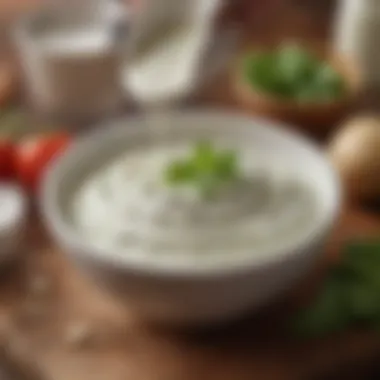
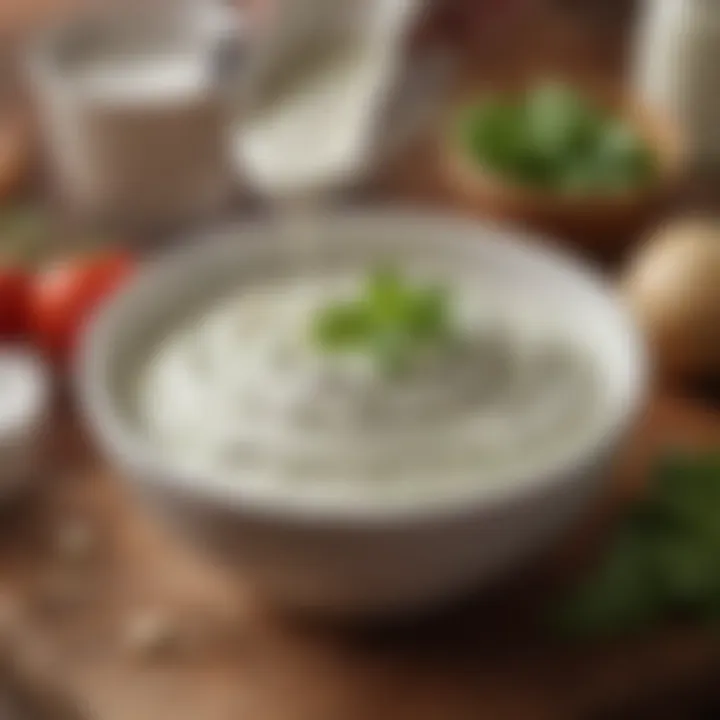
When it comes to homemade ranch dressing, consistency is key. A well-measured combination makes all the difference between a delightful ranch and a concoction that misses the mark.
- Use Standard Measuring Tools: Investing in a reliable set of measuring cups and spoons is a good idea. Whether you are gearing up to whip together a batch of ranch for a casual gathering or for your meal prep, having precision tools on hand ensures you’re sticking to the recipe.
- Wet versus Dry Measurements: It’s crucial to differentiate between wet and dry ingredients when you’re measuring. For liquids like buttermilk or vinegar, use a clear measuring cup to track the level accurately. For dry elements like spices or dried herbs, standard measuring spoons will suffice. This attention to detail could save your dressing from being too tangy or bland.
- Taste as You Go: Keep your taste buds engaged throughout the measuring process. As you add each ingredient, take a moment to evaluate if the balance feels right. This personal touch not only aligns with your preferences but also promotes an instinctual understanding of flavors.
- Document Your Ratios: If you stumble upon a winner in your measurements, jot down the ratios. It’s like having a well-guarded family recipe that you can revisit, ensuring that each future batch is just as scrumptious.
Mixing Techniques for Optimal Texture
Achieving the right texture is a balancing act, almost like a dance in the kitchen. The way you mix your ingredients can either lead to a creamy dressing or a lumpy mess. Here’s how to get it just right:
- Start with a Base: Begin by whisking your liquid components, such as buttermilk and mayonnaise, in a bowl. Use a whisk or a fork to ensure they’re smoothly combined. This foundation is essential to create that ideal creaminess.
- Gradual Incorporation of Dry Ingredients: When it comes to adding your spices and herbs, introduce them gradually. This way, they get fully incorporated without clumping up. Toss in garlic powder, onion powder, and salt gradually, whisking constantly.
- Avoid Overmixing: It might be tempting to whip that ranch dressing into a sublime froth, but overmixing can introduce air, altering the dense creaminess we crave. Aim for a smooth blend while keeping the dressing thick and luscious.
- Use a Food Processor for a Modern Twist: If you want to take texture control up a notch, consider using a food processor. This tool can efficiently chop fresh herbs as well as mix the ingredients together seamlessly, yielding a homemade ranch that’s impeccable in both flavor and consistency.
“Each ingredient contributes something unique; the magic lies in how you combine them.”
With these mixing techniques in tow, your ranch dressing will be a velvety indulgence that you can flaunt at any dinner table. Keeping a meticulous eye on both measurements and mixing methods ensures you’re on the path to ranch perfection.
Storing and Preserving Homemade Ranch Dressing
Homemade ranch dressing isn’t just a culinary delight; it also has a practical side when it comes to storage and preservation. Understanding how to store your ranch dressing properly can enhance its shelf life and maintain its flavor, saving you from any gastronomical disappointments. By taking the right steps, you can ensure that your dressing stays fresh and delicious for the days to come. In this segment, we will dig deep into the various storage methods and the crucial nuances concerning spoilage.
Proper Storage Methods
For keeping ranch dressing in prime shape, one must adhere to certain storage practices. First off, the container you choose can make all the difference. Opt for an airtight container; glass jars are often the preferred choice because they don’t retain odors like plastic can. An unexpected twist might occur if you happen to choose a lesser container.
- Chilling Is Key: The dressing should be kept in the fridge right after mixing. Exposure to room temperature can lead to a range of problems, from separating to inviting bacteria as guests, and we don’t want unwelcome company in our dressing!
- Portion Control: If you prepare large batches, it’s wise to store them in smaller portions. This not only helps in quicker consumption but also limits the number of times you need to open the storage container, which can affect freshness.
- Keep Away from Heat Sources: Ensure the dressing is stored away from stove tops or microwaves. Heat can break down ingredients quicker than you can say "ranch dressing!"
Shelf Life and Signs of Spoilage
Now, let’s talk about shelf life. Homemade ranch dressing does not include those artificial preservatives found in store-bought varieties, making it a bit more perishable. Generally, you can keep it in the fridge for up to two weeks if stored correctly. After that, it starts to lose both flavor and safety.
It’s always better to err on the side of caution; do not consume if in doubt.
However, just checking the date might not be enough. Here are a few tell-tale signs that your dressing has passed its prime:
- Off Smell: If it smells funky—definitely not like the ranch dressing you once knew—then it’s time to let it go.
- Separation: While slight separation is normal, if it’s excessive, or if you've noticed a layer of liquid forming, these can be indications of spoilage.
- Mold Growth: This one is as clear as day; if you see any mold, whether on the lid or within the dressing, don’t take any chances.
- Unpleasant Taste: This might be a hard way to find out, but if it tastes off, it's best to discard it.
In summary, proper storage techniques and awareness of spoilage signs will help enhance the shelf life of your beloved homemade ranch dressing. Remember, your culinary exploits deserve to shine and be enjoyed at their best, so treat your ranch dressing with the care it deserves!
Serving Suggestions and Pairing Options
When it comes to ranch dressing, it’s not just your run-of-the-mill condiment; it has the potential to elevate dishes to new heights. Understanding the right serving suggestions and pairing options can be crucial for a well-rounded meal. Picking the right companion for ranch dressing enhances textures and flavors, giving each bite a little burst of something delightful.
Complementary Foods for Ranch Dressing
Ranch dressing is incredibly versatile, pairing well with a variety of foods. From fresh vegetables to hearty meats, its creamy yet tangy profile works as a delightfully unexpected match. Here are some complementary foods that make ranch dressing shine:
- Fresh Veggies: Crunchy carrots, crisp cucumbers, and colorful bell peppers are excellent dippers that bring a balance of freshness and crunch.
- Wings and Fried Chicken: The richness of ranch stands up against the bold flavors of buffalo wings or crispy fried chicken, offering a cooling relief.
- Potato Dishes: French fries, baked potatoes, and even potato wedges reach a whole new level with a drizzle or dip of ranch on the side.
- Salads: As a dressing, ranch brings a creamy texture to mixed greens or even pasta salads, complementing other ingredients beautifully.
- Sandwiches: Think outside the box! Pour ranch dressing onto a turkey or ham sandwich for an added zing.
Creative Uses Beyond Dipping
Ranch dressing is not just for dunking your veg or slathering on a salad; its culinary capabilities stretch far beyond the confines of the plate. Here are some inventive ways to integrate ranch dressing into your cooking and meal prep:
- Marinades: Use ranch as a base for marinating chicken or seafood. The buttermilk helps tenderize protein while infusing a burst of flavor.
- Pizza Sauce: Switch it up and use ranch dressing as a pizza base instead of traditional sauce. It adds a tangy twist that pairs wonderfully with toppings like grilled chicken or bacon.
- Deviled Eggs: Replace your regular mayonnaise with ranch dressing in deviled egg filling for a zesty alternative that will leave your guests impressed.
- Baked Goods: Surprise everyone by incorporating ranch dressing into savory muffins or cornbread, where its creamy texture will add moisture and flavor.
Ranch dressing is more than just a side companion; it’s a key player in turning ordinary meals into extraordinary concoctions.
Whether you use it as a dip or as a flavor booster in dishes, the options are endless. Get creative and experiment in the kitchen—you might just discover your new favorite way to enjoy ranch dressing.
Final Thoughts on Homemade Ranch Dressing
Homemade ranch dressing isn't just a creamy condiment; it's a culinary canvas where flavors intermingle and personal tastes shine through. This section is pivotal for anyone keen on honing their craft, as it synthesizes the entire journey from ingredient selection to ultimate customization. Making your own ranch dressing elevates a typical meal into something special by allowing a creative flare to flourish.
Encouragement to Experiment
One of the most rewarding aspects of making ranch dressing at home is the freedom to experiment. Consider this: every ingredient has a personality. The tang of buttermilk pairs wonderfully with the zest of fresh herbs, while the creaminess of mayonnaise can be adjusted according to personal preference. Maybe throw in a hint of paprika for a subtle kick or a splash of vinegar to brighten the flavor.
Collaborate together these vibrant elements to create something uniquely yours. Don’t shy away from trying out new herbs like cilantro or experimenting with different acids such as apple cider vinegar. This is your dressing, tailor it to your specific palate. There are no rigid rules here; the kitchen is a playground, just waiting for your creativity.
The Joy of Crafting Personalized Flavors
There’s genuine joy found in creating your unique blend of ranch dressing. Just think about the satisfaction that comes from serving a dressing that reflects your individual taste. It's not merely about mixing; it's also about understanding how flavors meld or clash. The layered taste can transform a simple salad into an experience, making each bite a delightful surprise.
When you take the plunge into crafting personalized flavors, you discover the beauty of culinary artistry. Here’s where you can truly showcase your palate. Love garlic? Add more. Prefer something zesty? Lemon juice can be your best friend.
Home cooking is a chance to reflect who you are. Just as each cook brings their own style, ranch dressing offers a chance to articulate that culinary voice.
"Cooking is an expression of who you are and flavors tell your story. Embrace diversity in your kitchen!"







